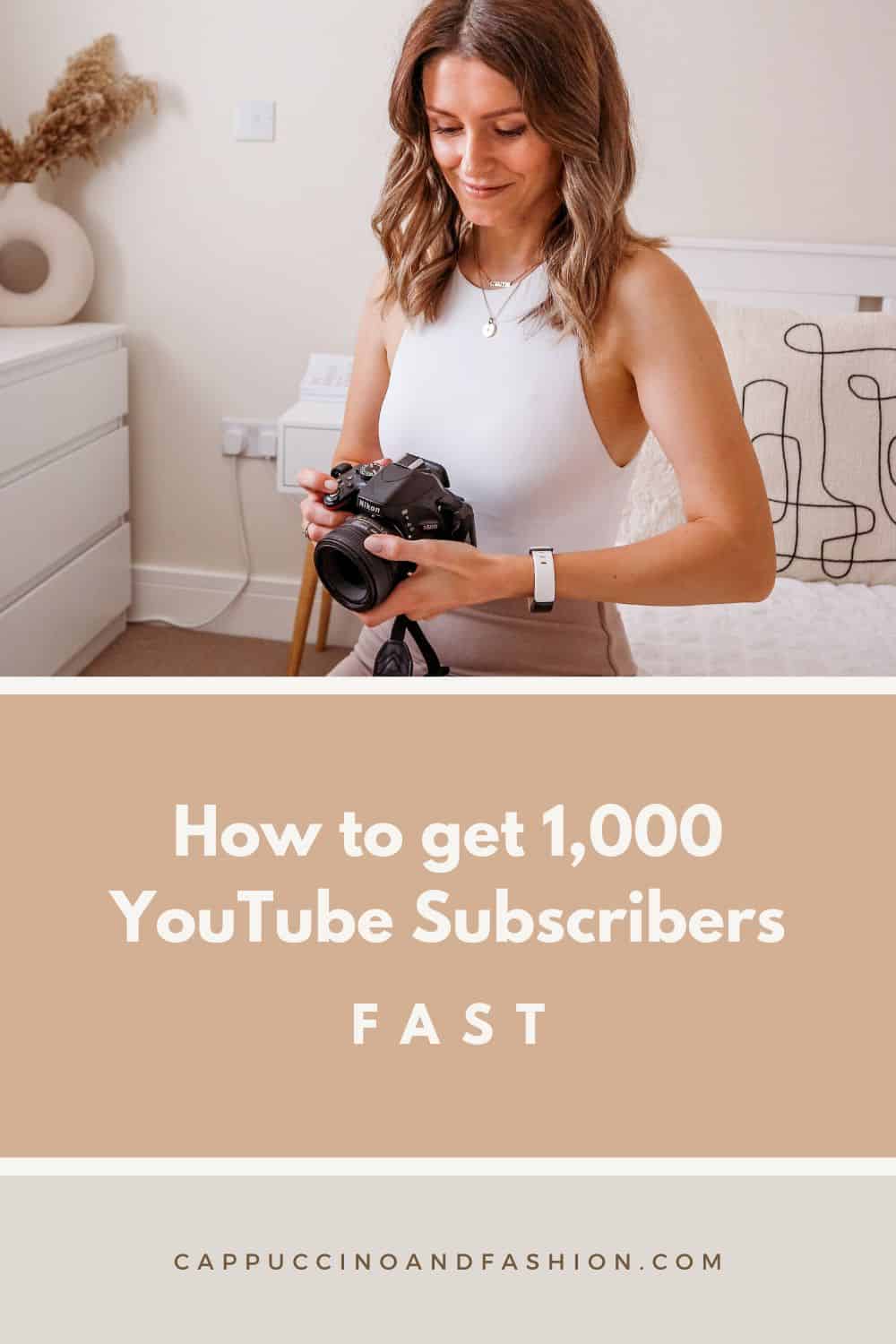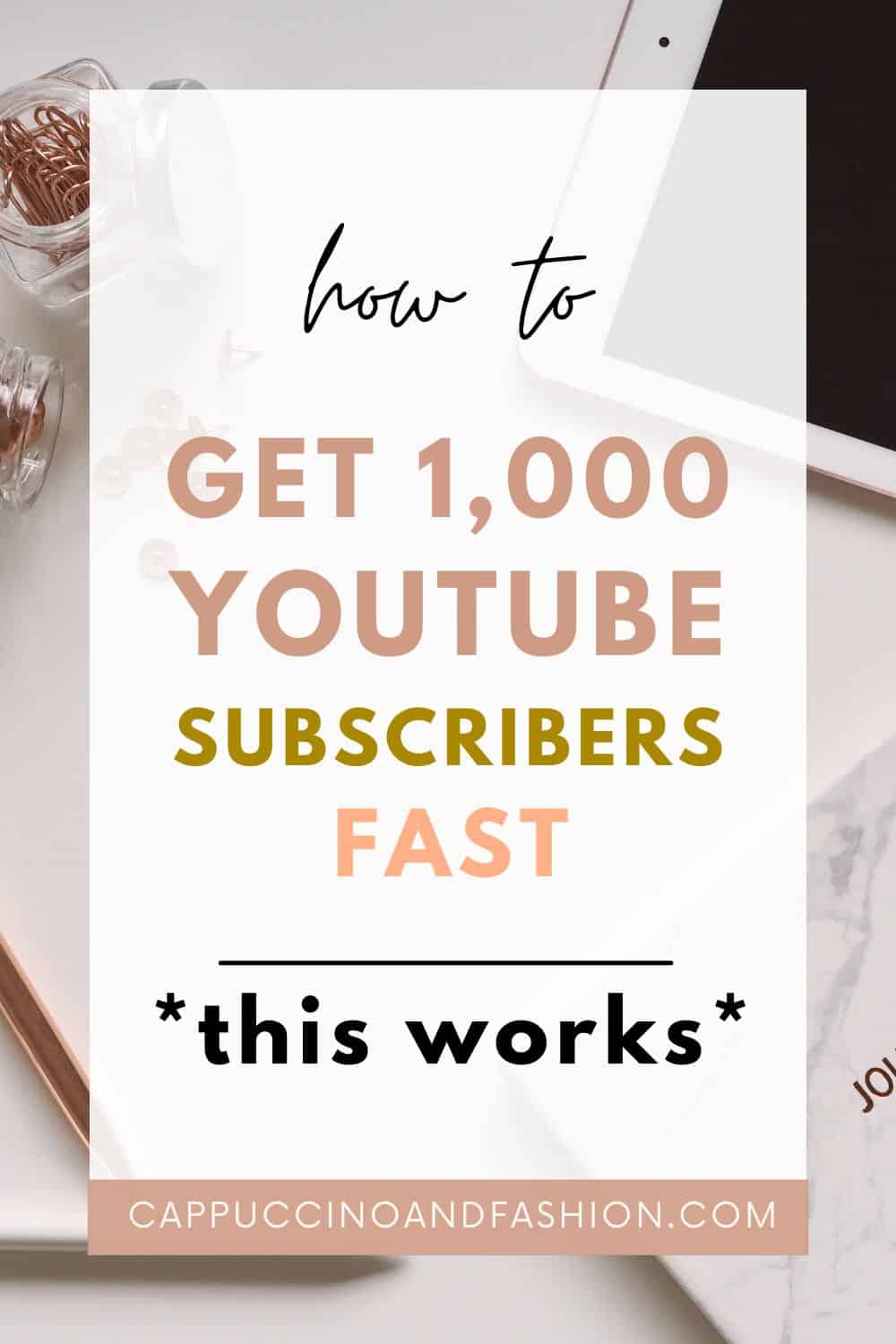This post may contain affiliate links, meaning I make a commission if you purchase through my links, at no extra cost to you. Disclosure here.
Have you been trying to grow your YouTube channel and it feels like such a struggle and slow process?
Then this blog post is for you because we’re going to get into how to get your first 1,000 subscribers on YouTube fast.
Now, it doesn’t mean you need to do this in 20 days or 30 days, because it needs to be sustainable for your own lifestyle as well.
I don’t feel like it’s productive to put necessarily a timeline on it, but we are going to dive into some of the things that you can do to speed up the process and to get there faster.
On my business YouTube channel I have over 3,000 subscribers, and then on my main YouTube channel I have 16k subscribers.
I’ve been around on YouTube for quite a while, and I have learned what actually works, what doesn’t and what is going to get you views on your YouTube channel.
Because if you can get views, then you also get subscribers, and those subscribers bring more views to your future videos.
It’s a snowball effect.
I’m going to share with you the 10 steps that you can take right now to really boost your YouTube channel.
You might also like:
How much I earn as a small YouTuber
Should you start a blog or a YouTube channel?
How to grow on YouTube without a niche
How to stay motivated as a YouTube creator

Free YouTube masterclass
Just quickly before we dive in, I wanted to mention my free YouTube masterclass that I put out recently.
This is my free YouTube masterclass that shows you exactly how to get your first $1,000 on YouTube.
In this blog post we’re going to cover how to get subscribers, but I do think it’s really important to know how to monetise that audience as well, right?
Because what’s the point of having subscribers if you’re not going to make any money off of it?
If you want to do this as a hobby, obviously that’s absolutely fine.
But if you’re trying to build a business and get something in return from creating content on YouTube, then you need to watch this masterclass.
I dive into my real stats, numbers, my real figures, case studies that I’ve done on my channels, and just about everything you need to know on how to monetise your YouTube channel.
How hard is it to get your first 1,000 subscribers on YouTube?
I’ll be honest with you. The milestone of 1,000 subscribers is probably the hardest to reach.
That’s for a few reasons:
- You’re still figuring out your niche, target audience, type of content etc.
- You probably don’t have a lot of confidence in yourself yet (see how to not care what people think of you as a YouTuber).
- You don’t have a strategy yet.
Once you reach that first 1,000 subscribers mark, things get easier.
You learn more of what works, you have a bit of an audience that comes back to watch your videos and you start having a bit more confidence in yourself.
Let’s dive into how to get those first 1,000 YouTube subscribers.
10 steps on how to get your first 1,000 subscribers on YouTube
Feel free to watch the video or keep on reading below:
Would you rather listen to the podcast on the go?
Listen to this podcast episode here:
Step 1: Learn who your target audience is
Step number 1 is to learn who your target audience really is.
If you don’t know this already, there’s no need to don’t panic.
You can do research on your audience in multiple ways, like going to Facebook groups.
For example, you can join Facebook groups that are kind of similar to the topic you want to create content on.
Then, in the search box of that Facebook group, type in things like “struggle” or “I don’t know how to” or “I have a problem” or any keywords like that.
Read what pops up.
Read what your audience is saying and try to really understand where they’re coming from, what they’re struggling with and what you could possibly assist them with.
Think about things you’ve gone through yourself that you can help them with.
Learning more about your target audience is so powerful, because if you can create content for them and create products for them, that’s going to really boost both your channel growth and your income as well.
If you don’t know who your target audience is, I would suggest sitting down, having a bit of a brainstorm, thinking about the kind of people who would like to watch your videos, why they would want to do that, and the type of content they might like to see.
It really helps to do research like look at other channels.
I’m not saying you should copy anything they’re doing.
I simply mean getting inspiration and having a feel for what works in that industry, in that niche, and for that target audience.
Step 2: Figure out what kind of content you will create
Step number 2 is to figure out what kind of content you will create and why your audience should care.
Obviously, if you know your target audience, you will probably start to figure out what kind of content they would like to see.
I would also suggest having a think yourself as to what kind of content either you like to watch or you feel you’re knowledgeable about or you feel like you could help somebody with.
And create content on that topic.
It doesn’t necessarily have to be a how-to or tips video.
It can also be just sharing your day-to-day life from the perspective of, for example, a student or a stay-at-home mom.
It’s all about that relatability factor.
If people can resonate with you or maybe if they can have a bit of escapism from their life, if that’s entertaining to them, obviously they will want to watch your channel more and more.
Step 3: Stop posting random vlogs
Step number 3 is a bit harsh, but it’s important.
Stop posting random vlogs.
The thing about vlogs is that they’re not searchable most of the time.
You might look at this and think, “Well, Madeline, you post a lot of daily life vlogs on your other channel.“
Yes, I do.
But I don’t post those daily life vlogs with the purpose of growing my audience.
I post them to nurture my audience, connect with them, and give them updates on what we’re up to.
I always try to make the title and topic of the vlog a bit searchable, so it’s not just something like “me going to the market”, because nobody is going to search for that and find my video through that.
However, when you’re just starting out and trying to grow, posting daily vlogs won’t help you much because you don’t have an audience yet.
You need to make sure that people can actually find your video first and that you build up an audience who cares first.
And that takes me to my next point.
Step 4: Make your videos searchable
When you go on YouTube, there’s a search bar where you can type in keywords and find a list of videos.
You want people to find your video in that list, ideally at the top, so they can watch it.
To achieve this, you need to optimise your video for search.
Do your keyword research and find the right keywords that you can rank for.
Tools like TubeBuddy or VidIQ can assist you in this process.
Personally, I use TubeBuddy for keyword research, and it’s really helpful.
Finding those good keywords that people search for will significantly boost your views and subscribers.
If you want more in-depth information on making your videos searchable, optimising them, and getting high view numbers, I cover these topics extensively in my YouTube course called Youtubeflix.
The course is designed to help you become a bingeable YouTube creator and is broken down into bite-sized content, so you don’t feel overwhelmed.

Step 5: Get suggested by YouTube
Becoming searchable on YouTube also increases the likelihood of being suggested by YouTube.
These are two separate aspects.
Being searchable means your video can be found through YouTube search.
Being suggested means YouTube actively promotes your video to a wide range of users on the platform.
Getting suggested by YouTube often leads to a significant increase in views and can cause a video to gain traction suddenly.
This has happened with several videos on both my channels.
The key is to create an optimised video that appears in search results and receives an initial wave of views.
When YouTube recognizes that the video is performing well, it may start promoting it to more users because it considers that it could be helpful to them.
As a result, your views continue to grow, you become more easily found in search, and the video gains momentum through YouTube’s suggestions.
This is how one of your videos can truly stand out.
Step 6: Double down on what’s working
Once you’ve posted a few videos and noticed which topics or types of videos receive a significant increase in views, it’s important to capitalise on that success.
When you notice a video performing really well, whether it’s due to the topic, thumbnail, or audience interest, it’s time to create more content around that subject.
Create another video on the same topic or create a series of videos within that theme.
By doing so, when viewers come across the initial video, they’ll have the opportunity to watch the entire playlist or series, turning you into a binge-worthy creator.
YouTube recognizes this engagement and is more likely to suggest your videos to a broader audience, leading to a substantial growth in subscribers.
Step 7: Your thumbnails matter
It is so important to have great thumbnails for your YouTube videos.
When you search for a keyword and browse the list of YouTube videos that appear in that search result, your video thumbnail must be able to compete with others.
It should stand out and be highly visible.
If your thumbnail includes text, it needs to be large, bold, and easily readable.
It’s also really important to provide viewers with a good reason to click on your video instead of others.
To gain insights into what an effective thumbnail is, spend time on YouTube. Observe successful videos, and carefully analyse their thumbnails.
What specifically catches your attention in that thumbnail.
Is it the person’s facial expression?
Is it the choice of text?
Is it the overall message conveyed?
Thoroughly examining these thumbnails will help you incorporate similar elements into your own thumbnails.
Thumbnails play a major role in getting clicks and gaining engagement on your videos.
Step 8: Your titles matter
Your video title also plays a huge role in the visibility of your channel.
YouTube uses the keywords in your video title to suggest it and display it in search results.
So when you perform your keyword research for a video you’re planning to film, take note of those keywords.
And include the relevant keywords in your video title.
This will greatly boost the visibility of your video, attract more views, increase subscribers, and ultimately help with your overall channel growth.
Step 9: People will subscribe if they find value
People subscribe to channels when they find value in the content.
A lot of people, including myself in the early days of my YouTube journey (which started in 2012), believe that actively promoting their channel to others is the key to channel growth.
For example, sending direct messages on Instagram with your channel link and asking people to watch or subscribe.
Or commenting on other channels in the hopes of getting people over to yours.
However, this approach doesn’t really work.
You can’t actively pursue every subscriber for your channel. It’s simply not doable logistically and it doesn’t work long term.
Instead of trying to chase subscribers, it’s much more helpful and productive to attract them instead.
The way that you attract subscribers (instead of chasing them) is through creating searchable and valuable content that resonates with your target audience.
Step 10: Share your YouTube channel on your social media
Sharing your YouTube channel on your social media platforms can be helpful.
Although it may seem contradictory to the previous point, I do not mean actively pushing your channel on others.
But rather making it easily accessible on your own social media profiles.
For example, you can include a link to your YouTube channel in your Instagram bio, on your blog, in your email list, and across any other platforms you use.
By doing so, if someone discovers and enjoys your content on one platform like Instagram, they may be inclined to click on the link and subscribe to your YouTube channel as well.
This helps you get that organic growth on your channel with an authentic audience that actually cares.
Bonus tip: Experiment with YouTube Shorts
It is worth experimenting with YouTube Shorts.
Shorts are a new-ish feature that allows you to create vertical format videos, kinda like Instagram Reels.
You can take snippets from your existing YouTube videos and repurpose them as vertical videos, which can be shared on platforms like Instagram Reels and YouTube Shorts.
While Shorts may not generate significant income directly, they have the potential to attract a good number of subscribers.
On my channel I noticed that when a Shorts video gains traction, it often leads to an influx of new subscribers.
So posting Shorts can be an effective way to promote your channel and to get new viewers to explore more of your content.
__
That’s how to get your first 1,000 subscribers on YoTube fast.
On top of this, it is so important to develop a monetisation strategy.
Simply waiting to become a YouTube Partner can be a lengthy process to start earning money and not a very lucrative one.
Instead, you can explore lots of other monetisation pathways and start generating income sooner with your YouTube channel.
For more info and help on monetising your YouTube channel effectively, you can access the free YouTube monetising masterclass.
Let me know in the comments below where you’re at with your YouTube channel.
How many YouTube subscribers do you currently have?
You might also like:
How much I earn as a small YouTuber
Should you start a blog or a YouTube channel?
How to grow on YouTube without a niche
How to stay motivated as a YouTube creator




